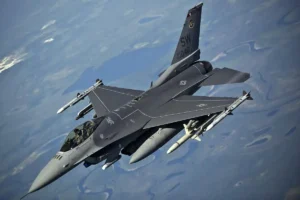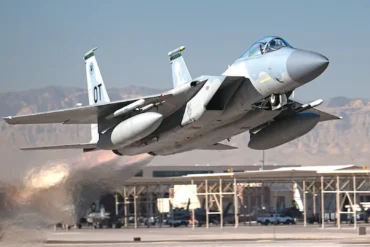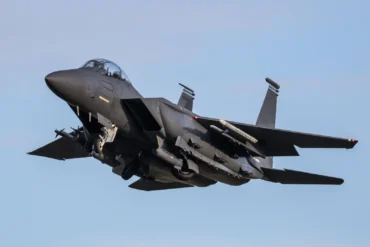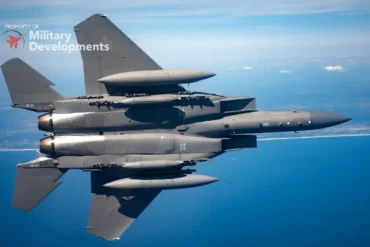The F-16 Fighting Falcon has solidified its reputation as one of the most versatile, reliable, and powerful multirole fighters in the world. With numerous variants of this aircraft in service, the F-16C Block 50 and Block 52 stand out due to their enhanced capabilities, especially in terms of their armament. These fighter jets are equipped with a wide variety of weaponry, making them adaptable to a wide range of missions, from air-to-air combat to precision strike and close-air support.
In this article, we will take a deep dive into the armament systems of the F-16C Block 50 and 52, covering everything from guns, rockets, and missiles to bombs and other ordnance that contribute to its combat prowess.
Guns: M61A1 Vulcan Cannon
The F-16C Block 50 and Block 52 are equipped with a 20mm M61A1 Vulcan 6-barrel rotary cannon, which serves as the primary internal weapon for close-range air-to-air and air-to-ground engagements. This cannon can fire at a rate of up to 6,000 rounds per minute, allowing the F-16 to engage targets with high accuracy and devastating firepower.
The M61A1 Vulcan is mounted internally in the aircraft, and it can carry up to 511 rounds of ammunition. The cannon’s high rate of fire, combined with its pinpoint accuracy, allows pilots to engage enemy aircraft or ground targets at close range effectively. Its relatively small size and weight enable the F-16 to retain maneuverability while still delivering significant firepower.
Hardpoints and Payload Capacity
The F-16C Block 50 and Block 52 are equipped with multiple hardpoints designed to carry a diverse array of weapons, sensors, and external fuel tanks. These hardpoints are strategically located across the aircraft to ensure balance and provide flexibility in mission configurations.
- Wing-tip air-to-air missile launch rails: The F-16 can carry two air-to-air missiles on its wing tips, ideal for engaging enemy aircraft at medium to long-range.
- Under-wing pylons: The fighter has six pylons under the wings, each capable of carrying a variety of air-to-ground or air-to-air ordnance, as well as fuel tanks.
- Under-fuselage pylons: There are three pylons under the fuselage, two of which are primarily used for sensor pods or other mission-specific equipment, while the third can carry additional weaponry or fuel.
The total weight capacity for these hardpoints is 17,000 lbs (7,700 kg), allowing the aircraft to carry a wide range of ordnance to suit various mission profiles.
Rockets: Versatility in the Sky and on the Ground
The F-16C Block 50 and Block 52 are equipped to carry a range of rocket pods that significantly enhance their capability for close-air support and suppression of enemy air defenses (SEAD).
Hydra 70 mm Rockets
- LAU-61/LAU-68 rocket pods: These pods are equipped with 19 Hydra 70 mm rockets in each pod, making them effective for precision strikes against light armor, soft targets, or enemy personnel. The LAU-68 pods carry 7 APKWS (Advanced Precision Kill Weapon System) rockets, which are laser-guided for greater accuracy.
CRV7 Rockets
- LAU-5003 rocket pods: These pods carry 19 CRV7 70 mm rockets each. The CRV7 is designed for both air-to-ground and air-to-air engagements, offering versatile strike capabilities, particularly in anti-armor operations.
Zuni Rockets
- LAU-10 rocket pods: Equipped with four Zuni 127 mm rockets, these pods are larger and more powerful, offering a greater punch against hardened targets or as part of anti-ship operations.
Air-to-Air Missiles
The F-16C Block 50 and Block 52 are well-equipped for air superiority missions, with a wide range of air-to-air missiles at their disposal.
- AIM-9 Sidewinder: The AIM-9 Sidewinder is a short-range infrared-guided missile used for close-in combat against enemy aircraft. The F-16 can carry six of these missiles, providing a strong defense against enemy fighters at shorter ranges.
- AIM-120 AMRAAM: For medium to long-range engagements, the AIM-120 AMRAAM is the primary missile carried by the F-16. The AMRAAM’s active radar seeker allows for target tracking without the need for continuous guidance from the launching aircraft, making it highly effective against enemy aircraft at significant distances. The F-16 can carry six AIM-120 missiles.
- IRIS-T and Python-4/5: These advanced infrared-guided missiles are effective for close-range engagements and are carried in addition to the standard AIM-9 and AIM-120 missiles. The F-16C Block 50 and 52 can carry up to six IRIS-T and six Python-4 or Python-5 missiles, depending on the mission requirements.
- AIM-7 Sparrow: The AIM-7 Sparrow is a radar-guided missile used for medium-range engagements. The F-16 can carry two AIM-7 Sparrow missiles alongside four AIM-9 Sidewinder missiles for enhanced operational flexibility.
Air-to-Surface Missiles: Precision and Power
The air-to-surface missiles on the F-16C Block 50 and Block 52 enhance its capability to strike ground targets with extreme precision, whether they are stationary or moving.
- AGM-65 Maverick: The AGM-65 Maverick is a highly effective, laser-guided missile designed for precision strikes against ground targets such as tanks, armored vehicles, and bunkers. The F-16 can carry up to six of these powerful missiles.
- AGM-88 HARM: The AGM-88 HARM (High-speed Anti-Radiation Missile) is used to target and destroy enemy radar systems, including surface-to-air missile (SAM) sites. This missile is critical in suppression of enemy air defenses (SEAD) missions. The F-16 can carry two of these missiles.
- AGM-158 JASSM: The AGM-158 Joint Air-to-Surface Standoff Missile provides the F-16 with long-range, standoff strike capability, allowing it to strike high-value targets from beyond the reach of enemy defenses.
- AGM-154 Joint Standoff Weapon (JSOW): The AGM-154 JSOW provides the F-16 with a versatile air-to-ground standoff capability. These missiles can strike a variety of target types from long distances, reducing the risk to the aircraft.
Anti-Ship Missiles
For naval operations, the F-16C Block 50 and Block 52 are equipped with anti-ship missile options, making them capable of striking enemy naval vessels from the air.
- AGM-84 Harpoon: The Harpoon is a well-known anti-ship missile that can target enemy surface vessels. The F-16 can carry up to two of these missiles, providing it with significant naval strike capability.
- AGM-119 Penguin: The Penguin missile is another anti-ship missile option that can be carried by the F-16, with up to four of these missiles available.
- Joint Strike Missile (JSM): The JSM, designed for integration with the F-16, offers a standoff strike capability against naval and land-based targets. This missile significantly enhances the F-16’s anti-ship strike capabilities.
Bombs: Versatility in Close-Air Support and Precision Strike
The F-16C Block 50 and 52 are equipped to carry a wide variety of bombs, ranging from general-purpose bombs to precision-guided munitions (PGMs).
General-Purpose Bombs
- Mark 82, Mark 83, and Mark 84: These are the standard general-purpose bombs in the U.S. Air Force arsenal. The F-16 can carry up to 12 Mark 82 bombs, 8 Mark 83 bombs, and 4 Mark 84 bombs, giving it significant flexibility in targeting both soft and hardened targets.
Cluster Munitions
- CBU-87, CBU-89, CBU-97: The CBU series of cluster bombs is designed for use against large formations of enemy troops, vehicles, and light armored vehicles. The F-16 can carry up to eight of these bombs, providing excellent area denial capability.
Precision-Guided Munitions (PGMs)
- GBU-39 SDB: The GBU-39 Small Diameter Bomb (SDB) offers the ability to hit targets with minimal collateral damage. The F-16 can carry up to eight of these bombs for highly precise strikes.
- Paveway and JDAM Series: The GBU-10, GBU-12, GBU-24, and GBU-27 Paveway series are laser-guided bombs, while the JDAM (Joint Direct Attack Munition) bombs are GPS-guided, offering exceptional accuracy in all weather conditions. The F-16 can carry a variety of these munitions, making it adaptable to various mission requirements.
Other Armament and Equipment
In addition to traditional ordnance, the F-16C Block 50 and 52 can carry a variety of other specialized equipment for electronic warfare, targeting, and reconnaissance.
- ADM-160 MALD: The Miniature Air-Launched Decoy (MALD) is a radar-jamming decoy designed to confuse enemy radar systems and reduce the risk of being targeted by air defense systems.
- Flares and Infrared Decoys: The F-16 can be equipped with SUU-42A/A pods, which dispense flares and infrared decoys to protect the aircraft from enemy heat-seeking missiles.
Conclusion: The F-16C Block 50 and 52’s Combat Effectiveness
The F-16C Block 50 and Block 52 variants are equipped with one of the most impressive and varied armament payloads in modern fighter jets. From a wide array of air-to-air and air-to-ground missiles to bombs and rockets, these fighters are built for multi-role flexibility, ensuring that they remain at the forefront of modern combat aircraft. The comprehensive weaponry suite, coupled with advanced avionics and combat systems, makes the F-16 a true powerhouse in modern air forces around the world.



